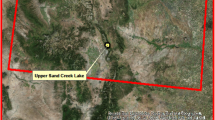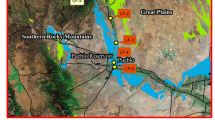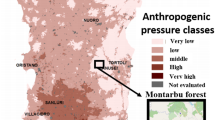Abstract
Total mercury (THg) and selenium (Se) were analyzed by Inductively Coupled Plasma Mass Spectrometry in 11 internal and external tissues and stomach contents from 23 brown trout, Salmo trutta, of a 22.9-km reach of a high-gradient stream (upper Fountain Creek) in Colorado, USA, impacted by coal-fired power plants, shale deposits, and urbanization. Trout and water were sampled from four sites ranging from 2335 to 1818 m elevation. Lengths, weights, and ages of fish between pairs of the four sites were not significantly different. The dry weight (dw) to wet weight (ww) conversion factor for each tissue was calculated with egg-ovary highest at 0.379 and epaxial muscle fourth highest at 0.223. THg and Se in stomach contents indicated diet and not ambient water was the major source of Hg and Se bioaccumulated. Mean THg ww in kidney was 40.33 µg/kg, and epaxial muscle second highest at 36.76 µg/kg. None of the tissues exceeded the human critical threshold for Hg. However, all 23 trout had at least one tissue type that exceeded 0.02 mg/kg THg ww for birds, and four trout tissues exceeded 0.1 mg/kg THg ww for mammals, indicating that piscivorous mammals and birds should be monitored. Se concentrations in tissues varied depending on ww or dw listing. Mean Se dw in liver was higher than ovary at the uppermost site and the two lower sites. Liver tissue, in addition to egg-ovary, should be utilized as an indicator tissue for Se toxicity.




Similar content being viewed by others
References
Arribére MA, Ribeiro GS, Budach DF, Arcagni M, Vigliano PH (2008) Selenium and mercury in native and introduced fish species of Patagonian lakes, Argentina. Biol Trace Elem Res 122:42–63
Besser JM, Canfield TJ, La Point TW (1993) Bioaccumulation of organic and inorganic selenium in a laboratory food chain. Environ Toxicol Chem 12:57–72
Bloom NS (1992) On the chemical form of mercury in edible fish and marine invertebrates. Can J Fish Aquat Sci 49:1010–1017
Can E, Yabanli M, Kehayias G, Asku Ö, Kocabaş M, Demir V, Kayim M, Kutluyer F, Şeker S (2012) Determination of bioaccumulation of heavy metals and selenium in tissues of brown trout Salmo trutta macrostigma (Duméril, 1858) from Munzer Stream, Tunceli, Turkey. Bull Environ Contam Toxicol 89:1186–1189
Canton S (2010) Persistence of some fish populations in high-Se environments. In: Chapman PM et al (eds) Ecological assessment of selenium in the aquatic environment. CRC Press, New York, pp 293–323
Chasar LC, Scudder BC, Stewart AR, Bell AH, Aiken GA (2009) Mercury cycling in stream ecosystems, trophic dynamics and methylmercury bioaccumulation. Environ Sci Technol 43:2733–2739
Ciardullo S, Aureli F, Coni E, Guandalini E, Iosi F, Raggi A, Rufo G, Cubadda F (2008) Bioaccumulation potential of dietary arsenic, cadmium, lead, mercury, and selenium in organs and tissues of rainbow trout (Oncorhychus mykiss) as a function of fish growth. J Agric Food Chem 56:2442–2451
Cizdziel J, Hinners T, Cross C, Pollard J (2003) Distribution of mercury in the tissues of five species of freshwater fish from Lake Mead, USA. J Environ Monit 5:802–807
Cumbie PM, Van Horn SL (1979) Selenium accumulation associated with fish mortality and reproductive failure. Proc Annu Conf Southeast Assoc Fish Wildl Agencies 32:612–624
Dames and Moore (1999) Final limited phase II subsurface investigation 212-acre parcel south of U.S. 24 and east of 21st Street, CO Springs, CO. Prepared for: Gold Hill Mesa JV, LLC. Job No. 42072-001-034
Day RW, Quinn GP (1989) Comparisons of treatments after an analysis of variance in ecology. Ecol Monogr 59:433–463
Eagles-Smith CA, Willacker Jr JJ, Flanagan Pritz CM (2014) Mercury in fishes from 21 national Parks in the western United States—inter- and intra-park variation in concentrations and ecological risk. USGS Open-File Report 2014-1051
Essig DA (2010) Arsenic, mercury, and selenium in fish tissue and water from Idaho’s major rivers: a statewide assessment. Ida Dep Environ Qual
Essig DA, Kosterman MA (2008) Arsenic, mercury, and selenium in fish tissue from Idaho lakes and reservoirs: a statewide assessment. Ida Dep Environ Qual
FishXing Version 3.0 Beta. 2006. http://www.stream.fs.fed.us/fishing/
Fresquez PR, Ferenbaugh JK (1999) Moisture conversion ratios for the foodstuffs and biota environmental surveillance programs at Los Alamos National Laboratory. Los Alamos Natl Lab Rep La-UR-99-253
Frøslie A, Norheim G, Sandlund OT (1985) Levels of selenium in relation to levels of mercury in fish from Mjøsa, a freshwater lake in southeastern Norway. Bull Environ Contam Toxicol 34:572–577
Hageman KJ, Simonich SL, Campbell DH, Wilson GR, Landers DH (2006) Atmospheric deposition of current-use and historic-use pesticides in snow at national parks in the western United States. Environ Sci Technol 40:3174–3180
Hall BD, Rosenberg DM, Wiens AP (1998) Methyl mercury in aquatic insects from an experimental reservoir. Can J Fish Aquat Sci 55:2036–2047
Harris RC, Bodaly RA (1998) Temperature, growth and dietary effects on fish mercury dynamics in two Ontario Lakes. Biogeochemistry 40:175–187
Herrmann SJ, Turner JA, Carsella JS, Lehmpuhl DW, Nimmo DR (2012) Bioaccumulation of selenium by the bryophyte Hygrohypnum ochraceum in the Fountain Creek Watershed, Colorado. Environ Manag 50:1111–1124
Jaffe D, Anderson T, Covert D, Kotchenruther R, Trost B, Danielson J, Simpson W, Berntsen T, Karlsdottir S, Blake D, Harris J, Carmichael G, Uno I (1999) Transport of Asian air pollution to North America. Geophys Res Lett 26:711–714
Kelly EN, Schindler DW, St. Louis VL, Donald DB, Vladicka KE (2006) Forest fire increases mercury accumulation by fishes via food web restructuring and increased mercury inputs. Proc Natl Acad Sci 103:19380–19385
Lazorchak JM, McCormick FH, Henry TR, Herlihy AT (2003) Contaminatioon of fish in streams of the mid-Atlantic region: an approach to regional indicator selection and wildlife assessment. Environ Toxicol Chem 22:545–553
Lemly AD (1985) Toxicology of selenium in a freshwater reservoir: implications for environmental hazard evaluation and safety. Ecotoxicol Environ Saf 10:314–338
Lemly AD (2002) Selenium assessment in aquatic ecosystems: a guide for hazard evaluation and water quality criteria. Springer, New York
Lu JY, Schroeder WH, Barrie LA, Steffen A, Welch HE, Martin K, Lockhart L, Hunt RV, Boila G, Richter A (2001) Magnification of atmospheric mercury deposition to polar regions in springtime the link to tropospheric zone depletion chemistry. Geophys Res Lett 28:3219–3222
May TW, Walther MJ, Saidi MK, Brumbaugh WG (2009) Total selenium and selenium species in irrigation drain inflows to the Salton Sea, California, October 2008 and January 2009. US Dep Inter. US Geol Surv, Open-File Rep 2009-1123
McGarvy CM (2011) A comparative study of mercury and selenium concentrations in fish tissues of the Fountain Creek Watershed, Colorado, USA. MS Thesis, Colorado State University—Pueblo
Mergler D, Anderson HA, Chan LHM, Mahaffey KH, Murray M, Sakamoto M, Stern AH (2007) Methylmercury exposure and health effects in humans: a worldwide concern. AMBIO 36:3–11
Moran PW, Alurn N, Black RW, Vijayan MM (2007) Tissue contaminants and associated transcriptional response in trout liver from high elevation lakes of Washington. Environ Sci Technol 41:6591–6597
Obrist D, Hallar AG, McCubbin I, Stephens BB, Rahn T (2008) Atmospheric mercury concentrations at Storm Peak laboratory in the Rocky Mountains: evidence for long-range transport from Asia, boundary layer contributions, and plant mercury uptake. Atmos Environ 42:7579–7589
Peterson SA, Van Sickle J, Hughes RM, Schacher JA, Echols SF (2005) A biopsy procedure for determining filet and predicting whole-fish mercury concentration. Arch Environ Contam Toxicol 48:99–107
Peterson SA, Sickle JV, Herlihy AT, Hughes RM (2007) Mercury concentration in fish from streams and rivers throughout the western United States. Environ Sci Technol 41:58–65
Peterson SA, Ralston NVC, Peck DV, Van Sickle J, Robertson JD, Spate VL, Morris JS (2009a) How might selenium moderate the toxic effects of mercury in stream fish of the western U.S.? Environ Sci Technol 43:3919–3925
Peterson SA, Ralston NVC, Whanger PD, Oldfield JE, Mosher WD (2009b) Selenium and mercury interactions with emphasis on fish tissue. Environ Bioindic 4:318–334
Presser TS, Sylvester MA, Low WH (1994) Bioaccumulation of selenium from geologic sources in western states and its potential consequences. Environ Manag 18:423–436
Sackett DK, Aday DD, Rice JA, Cope WG, Buchwalter D (2010) Does proximity to coal-fired power plants influence fish tissue mercury? Ecotoxicology 19:1601–1611
Sampaio da Silva D, Lucotte M, Paquet S, Brux G, Lemire M (2013) Inverse mercury and selenium concentration patterns between herbivorous and piscivorous fish in the Tapajos River, Brazilian Amazon. Ecotoxicol Environ Saf 97:17–25
Schmeltz D, Evers DC, Driscoll CT, Artz R, Cohen M, Gay D, Haeuber R, Krabbenhoht DP, Mason R, Morris K, Wiener JG (2011) MercNet: a national monitoring network to assess responses to changing mercury emissions in the United States. Ecotoxicology 20:1713–1725
Schroeder WH, Munthe J (1998) Atmospheric mercury: an overview. Atmos Environ 32:809–822
Schwindt AR, Fournie JW, Landers DH, Schreck CB, Kent ML (2008) Mercury concentrations in salmonids from western U.S. national parks and relationships with age and macrophage aggregates. Environ Sci Technol 42:1365–1370
Scudder BC, Chasar LC, DeWeese LR, Brigham ME, Wentz DA, WG Brumbaugh (2008) Procedures for collecting and processing aquatic invertebrates and fish for analysis of mercury as part of the National Water-Quality Assessment Program. USGS Open-File Report 2008-1208
Seiler RL (1998) Predicrion of lands susceptible to irrigation-induced selenium contamination of water. In: Frankenberger WT Jr, Engberg RA (eds) Environmental chemistry of selenium. Marcel Dakker, New York, pp 398–418
Sherman LS, Blum JD, Keeler JG, Demers JD, Dvonch JT (2012) Investigation of local mercury deposition from a coal-fired power plant using mercury isotopes. Environ Sci Technol 46:382–390
Sørmo EG, Ciesielski TM, Øverjordet IB, Lierhagen S, Eggen GS, Berg T, Jenssen BM (2011) Selenium moderates mercury toxicity in free-ranging freshwater fish. Environ Sci Technol 45:6561–6566
State of California (2007) Mercury contamination in fish from northern California lakes and reservoirs. Calif Dep Water Res
Steding DJ, Flegal AR (2002) Mercury concentrations in coastal California precipitation: evidence of local and trans-Pacific fluxes of mercury to North America. J Geophys Res 107(d24):ACH 11-1–11-7
Stewart R, Grosell M, Buchwalter D, Fisher N, Luoma S, Mathews T, Orr P, Wang W (2010) Bioaccumulation and trophic transfer of selenium. In: Chapman PM et al (eds) Ecological assessment of selenium in the aquatic environment. CRC Press, New York, pp 93–139
Stewart-Oaten A (1995) Rules and judgments in statistics: three examples. Ecology 76:2001–2009
U.S. EPA (1994) Analytical results report site inspection Gold Hill tailings site. EPA ID # COD983801275. Doc. # 448808 1994-10-14 00:00:00.0 Morrison Knudsen Corp., Englewood, CO 80111,
U.S. EPA (2001) Water quality criterion for the protection of human health: methylmercury. Office of Science and Technology, Office of Water. USEPA-823-R-01-001
U.S. EPA (2008) Model-based analysis and tracking of airborne mercury emissions to assist in watershed planning
U.S. EPA (2012) Assessment of mercury in fish tissue from select lakes of northeastern Oregon. EPA-910-R-12-001
U.S. EPA (2015) Extension of request for scientific views for external peer review draft aquatic life ambient water quality criterion for selenium—freshwater 2015. Fed Regist 80:44350–44354
U.S. Department of the Interior (1998) Guidelines for interpretation of the biological effects of selected constituents in biota, water, and sediment selenium. National irrigation water quality program information Report No. 344
Walters DM, Blocksom KA, Lazorchak JM, Jicha T, Angradi TR, Bolgrien DW (2010) Mercury contamination in fish in midcontinent great rivers of the United States: importance of species traits and environmental factors. Environ Sci Technol 44:2947–2953
Yeardley RB Jr, Lazorchak JM, Paulsen SG (1998) Elemental fish tissue contamination in northeastern U.S. lakes: evaluation of an approach to regional assessment. Environ Toxicol Chem 17:1875–1884
Yu JY, Schroeder WH, Barrie LA, Steffen A, Welch HE, Martin K, Lockhart L, Hunt RV, Boila G, Richter A (2001) Magnification of atmospheric mercury deposition to polar regions in springtime: the link to tropospheric ozone depletion chemistry. Geophys Res Lett 28:3219–3222
Zananski TJ, Holsen TM, Hopke PK, Crimmins PS (2011) Mercury temporal trends in top predator fish of the Laurentian Great Lakes. Ecotoxicology 20:1568–1576
Zhang H, Yin R, Feng X, Sommar J, Anderson CWN, Sapkota A, Fu X, Larssen T (2013) Atmospheric mercury inputs in montane soils increase with elevation: evidence from mercury isotope signatures. Sci Rep 3. doi:10.1038/srep03322
Acknowledgments
Funding for this research and publication costs were provided by the Board of Pueblo, Colorado, County Commissioners, the Lower Arkansas Valley Water Conservancy District, Colorado, and the Board of Water Works of Pueblo. The authors sincerely thank Dr. Jesse M. Lepak for determining the age of each fish using the otolith-sagitta methodology and Adam Pocius for assistance with the preparation of several figures.
Author information
Authors and Affiliations
Corresponding author
Rights and permissions
About this article
Cite this article
Herrmann, S.J., Nimmo, D.R., Carsella, J.S. et al. Differential Accumulation of Mercury and Selenium in Brown Trout Tissues of a High-Gradient Urbanized Stream in Colorado, USA. Arch Environ Contam Toxicol 70, 204–218 (2016). https://doi.org/10.1007/s00244-015-0241-9
Received:
Accepted:
Published:
Issue Date:
DOI: https://doi.org/10.1007/s00244-015-0241-9




